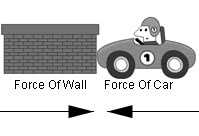Forces and Acceleration

Forces Act in Pairs
Whenever two objects interact they exert a force on each other.
The size of each force will be the same, but in the opposite direction. They are said to be equal and opposite.
The force from the wall equals the force of the car.

Balanced Forces
If the forces acting on an object are balanced they will not affect the movement of the object.
If the object is still, it will stay still.
If the object is moving, it will continue to move at a steady speed.
The forward force of the engine is equal to the force of friction from the road and air, so the car travels at a steady speed.
Unbalanced Forces
To alter the speed of the car the forces must be unbalanced.
If the force from the engine is bigger than friction, the car will accelerate.
If friction is greater than the force of the engine, the car will slow down.
The greater the size of the unbalanced force, the faster the object will speed up or slow down.
A stationary object will begin to move in the direction of the unbalanced force.
Force, Mass and Acceleration
To make an object accelerate an unbalanced force must act.
The greater the force, the greater the acceleration.
The mass of the object also affects the acceleration.
If the same force is applied to different sized objects, the object with less mass will accelerate faster.
Think about pushing a double-decker bus and a Mini. You would have to apply a much bigger force to make the bus accelerate at the same rate as the Mini.
Force, mass and acceleration are related in this equation:
Force | = | mass | x | acceleration | or | F = ma |
(N) |
| (kg) |
| (m/s 2 ) |
|
|
Document Actions

 Like us on Facebook
Like us on Facebook